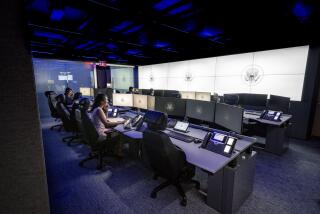A clean, well-lighted place for reporters
WASHINGTON — When he was president, George H.W. Bush would regularly stop by the White House press room on his way to the nearby Oval Office to chat with television crews and reporters.
Bleary-eyed after an all-night wait for election returns, President Ford stood at the lectern the day after the 1976 election and conceded that voters had turned him out of office.
The current president has made infrequent visits to the storied workspace, but he is planning to be there this morning to dedicate it after a recent makeover.
Like its earlier incarnations over the last 37 years, the room is still over President Franklin D. Roosevelt’s enclosed swimming pool, in an area that once also housed massage rooms and servants’ quarters -- metaphors, some might say, for a relationship between chief executive and the media criticized as overly cozy.
The 10-month renovation cost $8 million, 25% of which was assessed to news organizations. The rest was paid by the federal government.
The most visible result is an auditorium and small stage, equipped with up-to-date multimedia gadgets.
For more than 30 years, the White House press room was at a corner of the West Wing entrance, a location that allowed reporters to track visitors to the Oval Office by keeping an eye on the lobby.
During President Nixon’s early White House years, an elaborate lounge was built for the media over the pool, where a decade earlier President Kennedy was said to have cavorted with two young women known to reporters of that era as “Fiddle” and “Faddle.”
It was comfortable, club-like -- and offered no view of the president’s visitors. The overstuffed leather armchairs and sofas, along with the carpeting and coffee tables, prompted one wag in the press corps to crack, “I’ll have a drink, but I’m not going upstairs.”
By 1981, the chairs were worn, the carpet threadbare and the room ill-suited for reporters who increasingly transmitted the news electronically.
The Reagan administration rebuilt it. In came auditorium-style seats, a telegenic blue backdrop and the now-familiar oval emblem depicting the White House.
After 25 years, the room was in need of another overhaul, which will be dedicated today.
For the first time, it has air-conditioning that White House officials say will be up to the task of cooling an auditorium in which sometimes 100 people are crammed.
The view from the podium is of seven rows of seven blue-leather seats each and a tiered platform, where permanent stanchions provide space for cameras and technical gear.
The new seats are an inch wider than those installed by the Reagan team, which a White House official joked were to accommodate an expanding press corps.
Cables that formerly snaked across the floor have largely been placed out of sight. The pool, where Roosevelt sought relief from the effects of polio, remains beneath the steel-and-concrete floor. A jungle of fiber optic and other cables has been installed, but nearly all of the blue tiles remain.
Conventional television lights have been replaced with permanent -- and cooler -- light-emitting diodes.
The speaker’s lectern is flanked by twin 45-inch flat-panel video screens for the display of photographs, charts or speakers in remote locations.
Decorative columns and a higher ceiling are meant to impart a sense of visual dignity to a room that, when it’s not on camera, becomes a midafternoon dormitory and all-day mess hall for reporters and technicians.
Bush and his wife, Laura, plan to attend a ceremony, scheduled precisely for 8:05 this morning -- which happens to coincide with the start of the softer segments on the morning news shows.
It will be, White House Press Secretary Tony Snow said, “a simple ribbon-cutting ceremony.”
Will the president, whose most recent news conference was about seven weeks ago, escape from his first visit to the new press room without responding to questions?
“The president’s a big boy. He can handle even you,” Snow said to one reporter with a history of making pointed inquiries.
--
More to Read
Get the L.A. Times Politics newsletter
Deeply reported insights into legislation, politics and policy from Sacramento, Washington and beyond. In your inbox three times per week.
You may occasionally receive promotional content from the Los Angeles Times.










